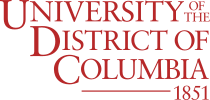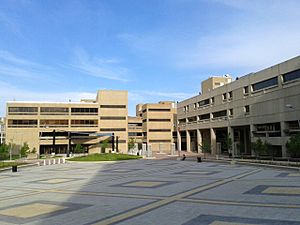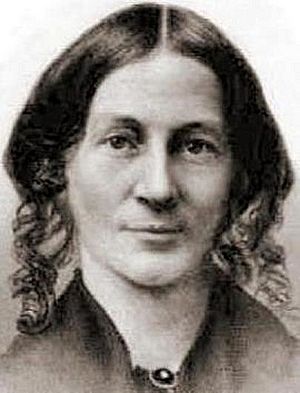University of the District of Columbia facts for kids
 |
|
|
Former names
|
Normal School for Colored Girls (1851–1879) Miner Normal School (1879–1929) Miner Teachers College (1929–1955) Washington Normal School (1873–1913) Wilson Normal School (1913–1929) Wilson Teachers College (1929–1955) District of Columbia Teachers College (1955–1977) Federal City College (1966–1977) Washington Technical Institute (1966–1977) Antioch School of Law (1972–1986) District of Columbia School of Law (1987–1996) |
|---|---|
| Motto | "Aspire, Accomplish, Take on the World" |
| Type | Public historically black land-grant university |
| Established | December 3, 1851 |
| Founder | Myrtilla Miner |
| Accreditation | MSCHE |
|
Academic affiliations
|
|
| Endowment | $49.1 million |
| President | Maurice Edington |
|
Administrative staff
|
3,747 (Fall 2018) |
| Undergraduates | 3,867 (Fall 2018) |
| Postgraduates | 633 (Fall 2018) |
| Location | , , |
| Campus | Large city, 23 acres (0.093 km2) |
| Colors | Red Gold |
| Nickname | Firebirds |
|
Sporting affiliations
|
NCAA Division II – ECC |
| Mascot | Felix the Firebird |
 |
|
The University of the District of Columbia (UDC) is a public university in Washington, D.C.. It is known as a historically black university and a land-grant university. UDC was started in 1851 and is the only public university in Washington, D.C.
UDC is part of the Thurgood Marshall College Fund. The university offers many types of programs. These include workforce training, certificates, and different college degrees like Associate, Bachelor's, Master's, and Doctoral degrees. UDC has several schools, such as the UDC Community College, the College of Arts and Sciences, and the David A. Clarke School of Law.
The main campus is in Van Ness in Northwest Washington, D.C. There are also other campuses and sites around the city. These include the Lamond-Riggs Campus, Congress Heights Campus, and a research farm in Beltsville, Maryland.
Contents
The History of UDC
The University of the District of Columbia was formed on August 1, 1977. This happened when three different colleges joined together: Teachers College, Federal City College, and Washington Technical Institute.
Normal School for Colored Girls
Myrtilla Miner started the Normal School for Colored Girls on December 3, 1851. She began with just six students in a small rented room. This was the first "normal school" in Washington, D.C. A normal school was a place that trained teachers.
The school helped young Black women become teachers. Important people like Henry Ward Beecher and his sister Harriet Beecher Stowe supported the school. Harriet Beecher Stowe even gave $1,000 from the sales of her famous book, Uncle Tom’s Cabin. Some people in the area were against the school, but it stayed open until the Civil War began.
After Myrtilla Miner passed away, the school reopened. By 1879, it was called Miner Normal School and became part of the public education system in D.C.
James Ormond Wilson Normal School
In 1873, another school was created in Washington D.C. for white girls. It was first called the Washington Normal School. In 1913, it was renamed the Wilson Normal School.
District of Columbia Teachers College
In 1929, the United States Congress made both Miner Normal School and Wilson Normal School into four-year colleges for teachers. Miner Teachers College was for African Americans, and Wilson Teachers College was for white people.
On July 1, 1955, after the important Brown v. Board of Education ruling, these two schools joined. They became the District of Columbia Teachers College, ending racial segregation in these schools.
Federal City College and Washington Technical Institute
In 1966, two more schools were created in D.C. by a new law:
- The Federal City College was a four-year college focused on liberal arts. It was meant to be a small school, but when it opened in 1968, many students applied.
- The Washington Technical Institute was a school for technical training.
Both of these new schools were given "land-grant status." This meant they received money from the government instead of land to help them grow.
University of the District of Columbia
Leaders wanted to combine the D.C. Teachers College, Federal City College, and Washington Technical Institute. This effort began after a law called the District of Columbia Home Rule Act was passed.
In 1975, the plan to merge the schools was approved. On August 1, 1977, the three schools officially became the University of the District of Columbia. Lisle C. Carter was the first president. Later, in 1996, the District of Columbia School of Law also joined UDC.
Around 2009, UDC changed how its programs were organized. They created a new Community College (UDC-CC) for programs like associate's degrees and job training. The main UDC campus continued to offer bachelor's and graduate degrees.
In recent years, UDC has worked to improve its programs and campus. In 2019, the university started the District of Columbia's Institute of Politics Policy and History. In 2020, they launched the Institute for the Study and Elimination of White Supremacy.
What You Can Study at UDC
UDC offers many different study programs. You can choose from 81 undergraduate (first college degree) and graduate (advanced college degree) programs. There are also practical training programs that help people get ready for jobs. The university is officially recognized by the Middle States Commission on Higher Education.
UDC has a law school called the David A. Clarke School of Law. It is one of only six historically Black law schools in the United States. The university also has the Felix Grant Jazz Archives, which is a large collection of jazz music and materials.
Schools and Colleges at UDC
Here are some of the main schools and colleges at UDC:
- College of Arts & Sciences (CAS)
- College of Agriculture, Urban Sustainability & Environmental Sciences (CAUSES)
- School of Business & Public Administration (SBPA)
- School of Engineering and Applied Sciences (SEAS)
- David A. Clarke School of Law
- University of the District of Columbia Community College (UDC-CC)
- Division of Workforce Development and Lifelong Learning
Notable Teachers
Some famous teachers have worked at UDC. These include Paul Cooke, who taught English and directed plays. Also, historian C.L.R. James taught at the university from 1972 to 1980.
International Programs
UDC used to have a partnership with the Modern Academy In Maadi in Cairo, Egypt. This allowed students in Cairo to earn UDC Bachelor's degrees in subjects like Computer Science and Business Administration. This partnership ended in 2014.
UDC Campus Life
The main campus of UDC is called the Van Ness campus. It is located in Northwest Washington, D.C., near the Van Ness–UDC Metrorail station.
UDC is mostly a school for students who live at home and travel to campus. However, in 2010, UDC opened its first student housing by leasing an apartment building. The university also planned to build a new residence hall and a student center.
The Van Ness Campus first opened in 1968 for the Washington Technical Institute. Over the years, more buildings were added to create the campus you see today.
Sports at UDC
The sports teams at the University of the District of Columbia are called the UDC Firebirds. They compete in the National Collegiate Athletic Association (NCAA) at the Division II level. They are part of the East Coast Conference (ECC).
UDC has ten varsity sports teams. These include:
- Men's sports: basketball, cross country, soccer, tennis, and lacrosse.
- Women's sports: basketball, cross country, tennis, indoor and outdoor track & field, and volleyball.
The university has plans to add men's and women's lacrosse and swimming teams in the future.
Student Activities
Greek Letter Organizations
UDC has several Greek-letter organizations, which are like clubs or fraternities and sororities. These include all nine of the National Pan-Hellenic Council organizations.
Student Media
Students at UDC publish a newspaper called The Trilogy. It shares news about campus events and other local and national news. There is also a yearbook called The Flightpath that features graduating students and activities from the year.
Television
UDC has its own cable television channel, Channel 19. It provides educational programs for adults. Another channel, Cable TV 98, supports teaching and research with educational television. It also helps train people to create their own public-access television shows.
Cost of Attending UDC
The University of the District of Columbia is a public university. This means it gets money from the local government of Washington, D.C., and the U.S. federal government. Because of this, the cost for students is lower than at private universities. For students who live in D.C., tuition is around $6,000 per year. Students from outside D.C. pay a bit more.
D.C. residents can also get scholarships through programs like the DC Futures Program, which can provide up to $8,000 to help with costs.
UDC Police Department
The UDC Police Department (UDCPD) is in charge of safety and security at the university. They provide police services for all UDC locations in Washington D.C., Maryland, and Virginia, 24 hours a day, every day of the year. The department has police officers and other staff. UDCPD officers can investigate crimes and make arrests on any UDC property.
Famous People Who Went to UDC
Many notable people have attended the University of the District of Columbia:
- Branislav Andjelić - A Serbian Internet pioneer and politician.
- Chase Fraser - A professional lacrosse player.
- Amadou Gallo - Vice President of NBA Africa.
- Denis Godwin Antoine - An ambassador for Grenada.
- Johnny Grier - The first African-American referee in the National Football League.
- Euphemia Haynes - The first African-American woman to earn a PhD in mathematics (in 1943).
- Norma Holloway Johnson - A former U.S. federal judge.
- Ruby Ruffin Hurley - An activist and official for the NAACP.
- Earl Jones - A professional NBA player.
- Dolores Kendrick Washington - A Poet Laureate of Washington, D.C.
- Cathy L. Lanier - The first female Chief of Police for the Metropolitan Police Department of the District of Columbia.
- Floretta Dukes McKenzie - A Superintendent of District of Columbia Public Schools.
- Lyn McLain - Co-founder of the DC Youth Orchestra Program.
- Aldon Lynn Nielsen - A poet.
- Richard Pennington - A former Chief of Police of Atlanta, Georgia.
- Portia Shields - The first female President of Albany State University.
- Frank Ski - A DJ, journalist, and radio personality.
- Abdul Thompson Conteh - A professional soccer player.
- Brian Thompson - Designer of the United States $100 bill.
- John Thompson - The first African-American head coach to win a major college basketball championship (with Georgetown Hoyas in 1984).
- Thelma Thompson - President of the University of Maryland Eastern Shore.
- Nadine Winter - The first African-American woman elected to the Council of the District of Columbia.
- Rasheim Wright - A Jordanian basketball player.
- Lennox Yearwood - President of the Hip Hop Caucus.
Images for kids
See Also
 In Spanish: Universidad del Distrito de Columbia para niños
In Spanish: Universidad del Distrito de Columbia para niños
- List of colleges and universities in Washington, D.C.
- Normal School for Colored Girls
- Felix Grant




